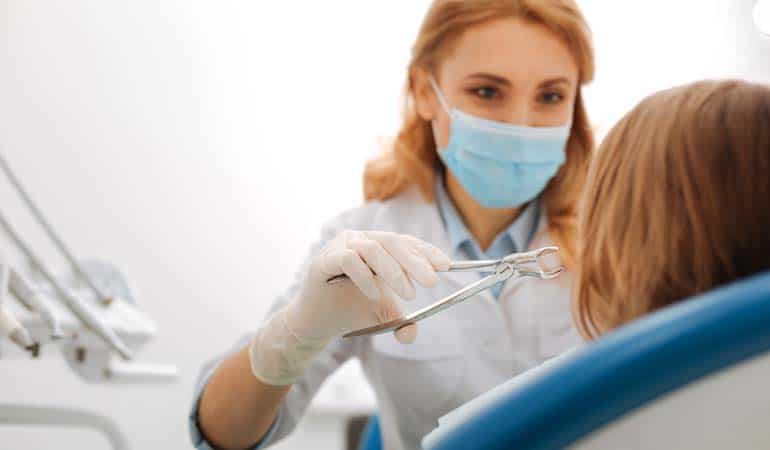
Tooth Extractions
Tooth extractions are a last and final resort, only performed when there are no viable options left to save them. An exception is wisdom teeth, which are usually recommended to be removed. Otherwise removing teeth is only done when there is no other way to keep them.
Uses:
This method is used to remove a tooth that can cause further damage if allowed to remain in the mouth. Infections could spread or pain can get so severe that retaining the tooth is not possible. Surgically removing wisdom teeth stops issues such as crowding and jaw pain from occurring.
Who Is It For:
Only people who are unable to save their teeth by any method are candidates for extraction. Broken teeth that cannot be repaired, wisdom teeth, and infected teeth sometimes make extraction necessary. Make sure that a replacement tooth, via a bridge, partial denture, or implant is in place as soon as possible to prevent further issues from arising.
The Procedure:
An anesthetic will help the patient feel no pain, but some people have a very real fear of having their teeth removed. In that instance, nitrous oxide can be employed to soothe them so that the procedure can be performed. The friendly staff at Live Better Health Center will walk you through each step of the procedure beforehand so that you know exactly what to expect.
After:
Our patients leave with detailed post-op instructions. A dressing will be placed on the wound and will need to be changed at regular intervals. The patient should refrain from using a straw to drink through, and they should not spit. Both actions can create a suction-like effect in the mouth which will encourage bleeding. Smoking is strictly prohibited because it can cause major health problems such as dry sockets (loss of the healing blood clot). A blood clot needs to form to act just like a scab and allow the area to heal. If the post-op instructions are used to the letter, then no issues should arise from this procedure. Antibiotics to prevent or treat infections are usually prescribed, as is pain medicine if needed.
What to expect:
Recovery should begin in a day or two, but there should be no pain at all if the patient adheres to the post-operative directions. Do not wait to replace the extracted tooth, though, because issues such as shifting can arise due to a missing tooth. Wisdom teeth do not need replacement.
Post-operative for extraction:
DO NOT RINSE YOUR MOUTH THE FIRST DAY.
Tomorrow, be sure to rinse your mouth gently every 3 to 4 hours (especially after meals), using 1/4 teaspoon of salt dissolved in a glass of warm (not hot) water. Saltwater speeds healing and helps remove food particles from the extraction site. Continue warm salt water rinses for the next several days.
DO NOT DRINK THROUGH A STRAW FOR 24 HOURS:
Drinking through a straw creates a suction in the mouth that may encourage bleeding.
DO NOT SPIT FOR HOURS:
Spitting also creates a suction-like effect in the mouth. Spitting can dislodge the healing blood clot that is forming in the hole.
Bleeding:
After extractions, some bleeding is to be expected. Be aware that a little blood mixed with saliva can appear to be bleeding more than it is. Pressure stops bleeding, so if bleeding persists, place a slightly dampened gauze pad over the bleeding area and bite down firmly for 30 minutes. (Dry gauze can disturb the blood clot, so dampen it ever so slightly.) Repeat later if necessary.
swelling:
An ice bag or chopped ice wrapped in a towel should be applied to the operated area for 30 minutes on, then 30 minutes off, for 4 to 5 hours. You can make your slushy ice pack by combining one part rubbing alcohol with three parts water in a heavy-duty baggie and placing it in the freezer. The mixture will not freeze completely hard, making a softer, more comfortable ice pack that you may wrap in a thin towel and apply to the affected area.
pain:
For mild to average pain, use any non-aspirin type of medication you like.
food:
A light, soft diet is advisable during the first 24 hours.
bony edges:
Small sharp bone fragments may work up through the gums during healing. These are not roots, and it is completely normal. If they become annoying, please call us and return to the office for their simple removal.

